Finest Fish Maw Soup
Historical and Cultural Significance
Finest fish maw soup, the swim bladder of large fish, is not just an ingredient; it’s a culinary heritage, deeply rooted in Asian cuisine. Esteemed for centuries, fish maw is considered one of the “Four Treasures” of the sea, alongside such delicacies as sea cucumber and abalone. Its historical significance stretches back to imperial banquets, where it was served as a symbol of opulence and prosperity. Today, fish maw continues to be a staple in celebratory meals and traditional festivals, embodying a rich cultural legacy.
Nutritional Value and Health Benefits
In addition to its cultural prestige, fish maw is a powerhouse of nutrition. Renowned for its high collagen content, it’s not only a beauty booster but also a boon for joint health. The spongy texture of fish maw allows it to absorb the flavors of other ingredients, making it not just healthful but also delicious. This collagen-rich ingredient is believed to aid in skin elasticity and overall vitality, making it a sought-after component in both culinary and wellness circles.
Selecting the Best Finest Fish Maw Soup
Types of Fish Maw and Their Characteristics
When you’re on the hunt for quality fish maw, knowing its types and characteristics is key. Fish maw generally comes in two varieties: fried and dried. Fried fish maw is light and puffy, absorbing flavors quickly and perfect for fast cooking. Dried fish maw, with a firmer texture, suits longer cooking times, infusing a rich taste into the soup.
The grade of fish maw varies. The top-tier ones are smooth and elastic, enhancing the soup’s texture, while lower grades might not deliver the same culinary delight. The fish maw’s origin also matters, as some regions are famed for their premium quality.
Tips for Selecting and Storing Fish Maw
Choosing fish maw involves checking for cleanliness, lack of odor, and consistent coloring. Steer clear of any piece with a strong fishy smell or discolored patches, as these signs suggest poor quality or storage.
In terms of storage, keep fish maw in a cool, dry place away from sunlight. Dried fish maw can last for months at room temperature, but once soaked, use it within a few days. Store fried fish maw in an airtight container to preserve its texture.
Preparing Finest Fish Maw Soup for Cooking
Cleaning and Soaking Techniques
Preparing fish maw starts with a thorough cleaning process. First, rinse the fish maw under cold running water to remove any impurities or residual particles. This step is crucial for ensuring a clean taste in your soup.
The next crucial step is soaking. Soaking rehydrates the fish maw and prepares it for cooking. For dried fish maw, soak it in cold water for several hours or overnight until it becomes soft and pliable. The soaking time varies depending on the thickness and type of fish maw. Some thinner varieties might only need a few hours, while thicker ones require longer soaking.
During the soaking process, change the water a few times to eliminate any unpleasant odors. For fried fish maw, a shorter soaking time in warm water is usually sufficient. It becomes soft and ready for cooking much faster than the dried variety.
Cutting and Pre-Cooking Procedures
Once the fish maw has softened, drain the water and gently squeeze out excess moisture. Then, cut the fish maw into pieces suitable for your recipe. The size of the pieces can vary based on personal preference and the specific recipe you are following.
Before adding fish maw to your soup, some recipes recommend a pre-cooking step. This might involve briefly blanching the fish maw in boiling water. Blanching helps to firm up the texture and remove any remaining impurities, ensuring that your fish maw is perfectly prepared to absorb the rich flavors of your soup.
Classic Finest Fish Maw Soup Recipes
Basic Ingredients and Their Roles
Creating the classic finest fish maw soup involves a harmonious blend of ingredients, each contributing its unique flavor and texture. The star, of course, is fish maw, known for its spongy texture that soaks up the rich broth. Other key ingredients include chicken or vegetable broth as the soup base, providing a hearty and flavorful foundation. Ingredients like ginger and garlic are essential for their aromatic qualities, enhancing the soup’s overall taste.
Seafood elements such as shrimp, squid, or crab meat are often added, enriching the soup with oceanic flavors. Mushrooms, typically shiitake or straw mushrooms, bring an earthy depth, while ingredients like goji berries or dates add a subtle sweetness. Cornstarch is used for thickening the soup, giving it the desired consistency. Finally, seasonings like soy sauce, oyster sauce, sesame oil, salt, and pepper are used to fine-tune the flavor profile of the soup.
Step-by-Step Cooking Instructions
- Preparation of Ingredients: Begin by soaking the fish maw as per the guidelines discussed earlier. Prepare other ingredients – chop the vegetables, slice the mushrooms, and prepare the seafood elements.
- Broth Preparation: Start with heating the chicken or vegetable broth in a large pot. Add aromatics like ginger and garlic to infuse the broth with their flavors.
- Adding Main Ingredients: Once the broth is simmering, add the soaked and prepared fish maw and other seafood elements like shrimp or crab meat. Let them cook until they are just done to avoid overcooking the seafood.
- Incorporating Additional Flavors: Add mushrooms, goji berries, or dates, followed by seasonings like soy sauce, oyster sauce, and sesame oil. Adjust the taste with salt and pepper.
- Thickening the Soup: Dissolve cornstarch in a small amount of water and slowly add it to the soup, stirring constantly. This will thicken the soup and give it a silky texture.
- Final Adjustments and Serving: Taste the soup and adjust seasonings if necessary. Once everything is cooked to perfection, serve the soup hot, garnished with chopped spring onions or cilantro for an added burst of freshness.
Innovative Variations of Fish Maw Soup
Incorporating International Flavors
Fish maw soup, traditionally an Asian delicacy, offers a canvas for a fusion of international flavors. By incorporating ingredients from various cuisines, you can transform this classic soup into a global gourmet experience.
- Mediterranean Fusion: Imagine a version where you infuse olive oil, saffron, and a touch of tomato paste, blending the richness of the Mediterranean palate into the Asian-inspired soup.
- Spicy Twist: For those who favor a bit of heat, adding ingredients like chili peppers, paprika, or even a dash of curry can create a soup that tantalizes the taste buds with its spicy undertones.
- Herbal Infusions: Incorporating herbs like thyme, rosemary, or basil can add a refreshing and aromatic dimension to the soup, appealing to those who enjoy a hint of Western herbaceous flavors.
These adaptations not only enhance the flavor profile but also celebrate the fusion of diverse culinary traditions.
Vegetarian and Vegan Adaptations
Fish maw soup can also be adapted for vegetarian and vegan diets, ensuring everyone can enjoy this exquisite dish.
- Vegetarian Version: You can substitute fish maw with tofu skin or konjac, which offer a similar texture. For the broth, use a rich vegetable stock and add an assortment of vegetables like bok choy, carrots, and mushrooms to make it hearty and nutritious.
- Vegan Delight: Create a vegan version by using plant-based broth and adding vegan seafood alternatives available in the market. Enhance flavors with ingredients like seaweed, which adds a seafood-like umami flavor without using any animal products.
These adaptations allow the essence of the traditional fish maw soup to shine through while catering to different dietary preferences. They demonstrate the versatility of this dish and its ability to evolve and embrace new tastes and lifestyles.
Cooking Tips and Techniques
Enhancing Flavors and Textures
Mastering fish maw soup is about striking the right balance between flavor and texture. Here are some tips to elevate your soup to the next level:
- Layering Flavors: Start by gently sautéing aromatics like garlic, ginger, or shallots before adding the broth. This step releases their essential oils and builds a flavor base.
- Quality of Broth: The broth is the backbone of your soup. Using a homemade stock, whether it’s chicken, vegetable, or seafood, can significantly enhance the taste compared to store-bought versions.
- Balancing Seasonings: Adjust the seasoning gradually. Start with a light hand and taste as you go. Remember, you can always add more salt or soy sauce, but you can’t take it away.
- Gentle Cooking: Fish maw should be cooked gently to maintain its delicate texture. Avoid boiling the soup vigorously once the fish maw is added, as this can make it tough and chewy.
Common Mistakes to Avoid
Even experienced cooks can encounter pitfalls when preparing fish maw soup. Here are some common mistakes to avoid:
- Over-soaking Fish Maw: Soaking fish maw for too long can make it too soft and lose its texture. Follow the recommended soaking times based on the type and thickness of the fish maw.
- Overcrowding the Pot: Give each ingredient its space to cook evenly. Overcrowding can lead to uneven cooking and a reduction in flavor quality.
- Rushing the Process: Good soup takes time. Rushing the cooking process can result in underdeveloped flavors. Allow enough time for the ingredients to meld together harmoniously.
Pairing and Serving Suggestions
Choosing the Right Accompaniments
When you pair fish maw soup with the right side dishes and drinks, you enhance the overall dining experience. Steamed rice, with its neutral flavor, complements the soup beautifully. For added texture and color, stir-fried vegetables like bok choy or snow peas are excellent choices. Noodles such as rice noodles or udon also pair well, absorbing the soup’s flavors.
For beverages, green or jasmine tea can refresh the palate and aid digestion. If you prefer wine, a light white wine like Sauvignon Blanc or a Pinot Noir complements the soup’s flavors without overwhelming them.
Presentation and Garnishing Tips
Presenting fish maw soup elegantly can significantly boost its appeal. Before serving, garnish with fresh herbs like cilantro or scallions for color and flavor. Adding a drizzle of sesame oil enhances aroma, while a sprinkle of fried garlic or shallots adds crunch.
Serve the soup hot for the best experience, using heat-retaining bowls. Traditional Asian soup spoons can add authenticity to the serving.
Cultural and Festive Serving Traditions
Fish maw soup often stars in cultural and festive meals. In Chinese celebrations like the Lunar New Year, it symbolizes prosperity and health, served in communal bowls to emphasize family and sharing.
In other Asian cultures, unique serving traditions accompany fish maw soup, such as special garnishes or rituals, enriching the communal dining experience and the cultural significance of the dish.
By smartly pairing, focusing on presentation, and respecting cultural traditions, you elevate the simple act of serving fish maw soup into a memorable dining experience.
FAQs about Fish Maw Soup
Alternative Ingredients and Substitutes
Can I use something other than fish maw in the soup?
Yes, you can. For those who might not have access to fish maw or prefer a different texture, several alternatives can be used. Tofu skin, sea cucumber, or even certain types of mushrooms can serve as substitutes, offering a similar gelatinous texture. Keep in mind, though, that each substitute will bring its unique flavor and texture to the dish.
What are some alternatives for seafood in the soup?
For a non-seafood version, you can use chicken, pork, or beef. These meats offer a different flavor profile and can be just as satisfying. Vegetarians can opt for additional vegetables like bamboo shoots or lotus roots, or use mock seafood products available in the market.
Storage and Reheating Tips
How should I store leftover fish maw soup?
Store the leftover soup in an airtight container in the refrigerator. It’s best to consume it within 3 to 4 days. If the fish maw is already mixed in, remember that its texture may change slightly upon reheating.
Can I freeze fish maw soup?
Yes, you can freeze fish maw soup, but it’s advisable to do so without the fish maw as its texture might change after thawing and reheating. Freeze the broth separately and add fresh fish maw when you’re ready to reheat and serve the soup.
What’s the best way to reheat fish maw soup?
Reheat the soup over a gentle heat on the stove. If it has thickened in the fridge, you might need to add a little water or broth to adjust the consistency. Remember to add the fish maw towards the end of the reheating process to maintain its texture.
Conclusion
As you embark on the culinary adventure of preparing the finest fish maw soup, remember that each step, from choosing the best fish maw to the final garnish, is an artful expression of both tradition and personal creativity. This comprehensive guide has provided insights and tips to ensure that even beginners can create a dish rich in flavor and steeped in cultural heritage.
Embracing the traditional recipe or experimenting with innovative variations highlights the versatility of fish maw soup, making it adaptable to a wide range of tastes and dietary needs. Therefore, whether you’re adhering to the classic preparation or infusing your unique twist, it’s an opportunity to weave a tapestry of flavors and textures that echo history, health, and culinary finesse.
In essence, mastering these recipes and tips doesn’t just mean cooking a meal; it’s about crafting an experience that combines history, health, and the art of cooking. So, dive into this challenge, enjoy the process, and bask in the rich, exquisite taste of your homemade fish maw soup.








